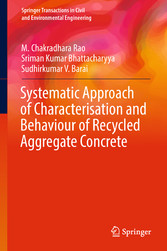Suche
Lesesoftware
Specials
Info / Kontakt
Systematic Approach of Characterisation and Behaviour of Recycled Aggregate Concrete
von: M. Chakradhara Rao, Sriman Kumar Bhattacharyya, Sudhirkumar V. Barai
Springer-Verlag, 2018
ISBN: 9789811066863 , 349 Seiten
Format: PDF, Online Lesen
Kopierschutz: Wasserzeichen




Preis: 96,29 EUR
eBook anfordern 
Mehr zum Inhalt

Systematic Approach of Characterisation and Behaviour of Recycled Aggregate Concrete
Foreword
8
Preface
10
Acknowledgements
13
Contents
15
About the Authors
19
Symbols and Abbreviations
21
List of Figures
25
List of Tables
35
1 Introduction
39
1.1 Introduction
39
1.2 Applications of Recycled Aggregates
43
1.3 Benefits of Recycled Aggregates
46
1.3.1 Economic Aspects
47
1.3.2 Reducing Environmental Impacts
48
1.3.3 Saving Resources
48
1.4 Constraints of Recycled Aggregate Concrete
49
1.4.1 Management Problems (Tam and Gao 2003)
49
1.4.1.1 Lack of Suitable Regulations
49
1.4.1.2 Lack of Codes, Specifications, Standards and Guidelines
49
1.4.1.3 Lack of Experience
49
1.4.2 Technology Problems
49
1.4.2.1 Cement Mortar Attached to Aggregate
50
1.4.2.2 Poor Grading
50
1.4.2.3 High Porosity of Recycled Aggregates
50
1.4.2.4 Weak Interfacial Transition Zone
50
1.4.2.5 Transverse Cracks Generated
50
1.4.2.6 Variations in Quality
51
1.4.2.7 High Impurity
51
1.4.2.8 Low Quality
51
1.5 Classification of Recycled Aggregates
52
1.6 Current Global Scenario
52
1.6.1 Japan
52
1.6.2 Germany
56
1.6.3 United Kingdom
58
1.6.4 Hong Kong
61
1.6.5 Australia
63
1.6.6 China
63
1.6.7 Spain
66
1.6.8 RILEM Specifications
68
1.6.9 India
68
1.7 Summary
72
References
73
2 Demolition Techniques and Production of Recycled Aggregate
77
2.1 Introduction
77
2.2 Methods of Demolition
78
2.2.1 Non-engineering Demolition
79
2.2.2 Engineering Demolition Techniques
80
2.2.2.1 Mechanical Methods
80
2.2.2.2 Demolition by Implosion or Explosion
84
2.2.2.3 Deconstruction
84
2.2.3 Top-Down demolition
85
2.3 Production Technology of Recycled Aggregates
85
2.3.1 Mobile Plants
89
2.3.2 Stationary/Fixed Plants
92
2.4 Process of Recycling Technology
93
2.4.1 Jaw Crusher
93
2.4.2 Impact Crusher
93
2.4.3 Gyratory Crushers
94
2.4.4 Pre-crushing Separation
96
2.5 Summary
98
References
99
3 Properties of Recycled Aggregates
102
3.1 Introduction
102
3.2 Physical Properties of Recycled Aggregates
103
3.2.1 Grading, Shape and Surface Texture
103
3.2.2 Density and Specific Gravity
105
3.2.3 Water Absorption
108
3.2.4 Flakiness and Elongation Indices
112
3.3 Mechanical Properties of Recycled Aggregates
113
3.3.1 Aggregate Crushing Value
113
3.3.2 Los Angeles Abrasion Resistance Value
114
3.4 Summary
116
References
117
4 Properties of Recycled Aggregate Concrete
119
4.1 Introduction
119
4.2 Workability
119
4.2.1 Factors Influencing the Workability
119
4.2.1.1 Effect of Water Requirement on Workability
120
4.2.1.2 Influence of Moisture State of Recycled Aggregate
122
4.2.1.3 Influence of Strength of Parent Concrete
126
4.3 Mechanical Properties
129
4.3.1 Compressive Strength
129
4.3.1.1 Effect of Amount of Recycled Aggregate
130
4.3.1.2 Effect of Method of Curing
135
4.3.1.3 Effect of Strength of Parent Concrete
136
4.3.1.4 Effect of W/C Ratio
142
4.3.1.5 Effect of Moisture State of RA
143
4.3.2 Static Modulus of Elasticity
146
4.3.3 Split Tensile Strength
152
4.3.4 Flexural Strength
162
4.3.5 Density
166
4.3.6 Ultrasonic Pulse Velocity (UPV)
170
4.4 Interrelationships Among Mechanical Properties
175
4.4.1 Relationship Between Compressive Strength and Split Tensile Strength
177
4.4.2 Compressive Strength and Flexural Strength or Modulus of Rupture Relationship
179
4.4.3 Compressive Strength and Static Modulus of Elasticity Relationship
181
4.4.4 Compressive Strength and Ultrasonic Pulse Velocity (UPV) Relationship
183
4.4.5 Compressive Strength and Density Relationship
184
4.5 Summary
185
References
188
5 Long-Term and Durability Properties
194
5.1 Introduction
194
5.2 Shrinkage
195
5.2.1 Influence of Amount of Recycled Aggregate
195
5.2.2 Effect of Quality of Recycled Aggregate
197
5.2.3 Effect of Mineral Admixtures
201
5.2.4 Effect of Source Concrete, Crushing Method, and Age of Crushing
203
5.2.5 Effect of Method of Curing
205
5.2.6 Effect of Method of Mixing
206
5.3 Creep
208
5.3.1 Effect of Water to Cement (w/c) Ratio
209
5.3.2 Effect of Mineral Admixtures
210
5.3.3 Effect of Method of Curing and Period of Curing
212
5.3.4 Estimation of Creep of RAC
213
5.4 Durability Performance of RAC
214
5.4.1 Permeability
214
5.4.2 Chloride Penetration
222
5.4.3 Carbonation Depth
231
5.5 Summary
236
References
239
6 Microstructure of Recycled Aggregate Concrete
243
6.1 Introduction
243
6.2 Sample Preparation for Microscopic Study
245
6.3 Scanning Electron Microscope (SEM)
246
6.4 Image Acquisition
246
6.5 Image Analysis
247
6.6 Vickers Microhardness (HV)
248
6.7 Characteristics of Interfacial Transition Zone (ITZ)
248
6.7.1 Hydration Compounds, Anhydrous Cement, and Porosity
254
6.7.2 Distribution of Hydration Compounds, Anhydrous Cement, and Porosity Across the Width of ITZ
257
6.7.3 Effect of Aggregate
265
6.8 Compressive Strength–Porosity Relationship
266
6.9 Microhardness of ITZ
268
6.10 Compressive Strength–ITZ Microhardness Relationship
271
6.11 Influence of Binder on ITZ
272
6.12 Influence of the Water–Binder Ratio, Quality and Quantity of Adhesion Mortar
274
6.13 Influence of Strength of Source Concrete
278
6.14 Influence of Treatment of RCA on ITZ
279
6.15 Summary
279
References
280
7 Structural Behavior of RAC
282
7.1 Introduction
282
7.2 Impact Behavior
283
7.2.1 Instrumented Drop Hammer Impact Test Setup and Devices
285
7.2.2 Impact Test Results
287
7.2.2.1 Accelerations
287
7.2.2.2 Displacement
293
7.2.2.3 Strains
294
7.2.2.4 Support Reactions
297
7.2.2.5 Failure Pattern
299
7.3 Flexural Behavior of RAC
300
7.4 Shear Behavior of RAC
304
7.5 Other Structural Aspects
306
7.6 Summary
307
References
307
8 Quality Improvement Techniques
309
8.1 Introduction
309
8.2 Quality Improvement Techniques for Recycled Aggregate
309
8.2.1 Mechanical Treatment
310
8.2.2 Thermal Treatment
312
8.2.3 Chemical Treatment (Tam et al. 2007a, b)
314
8.2.4 Three-Step Method (Gao et al. 2013)
322
8.3 Impregnation Techniques
323
8.3.1 Silica Fume Impregnation
323
8.3.2 Ultrasonic Cleaning
324
8.3.3 Polymer Emulsion Impregnation
329
8.3.4 Surface Treatment with Nanomaterials
331
8.4 New Mixing Techniques
334
8.4.1 Two-Stage Mixing Approach
334
8.4.2 Diversifying Two-Stage Mixing Approach
338
8.4.3 Self-healing
340
8.5 Summary
340
References
342
Appendix A: Additional Results of Microstructure of Concrete
344
A.1 Introduction
344






